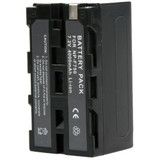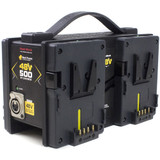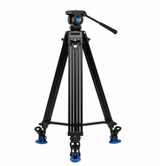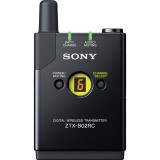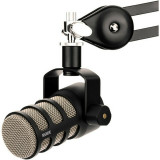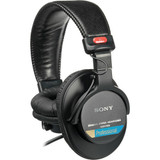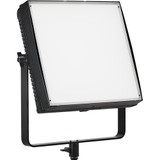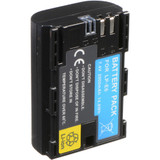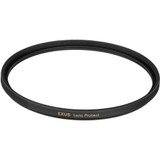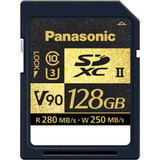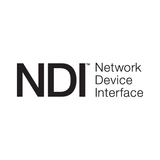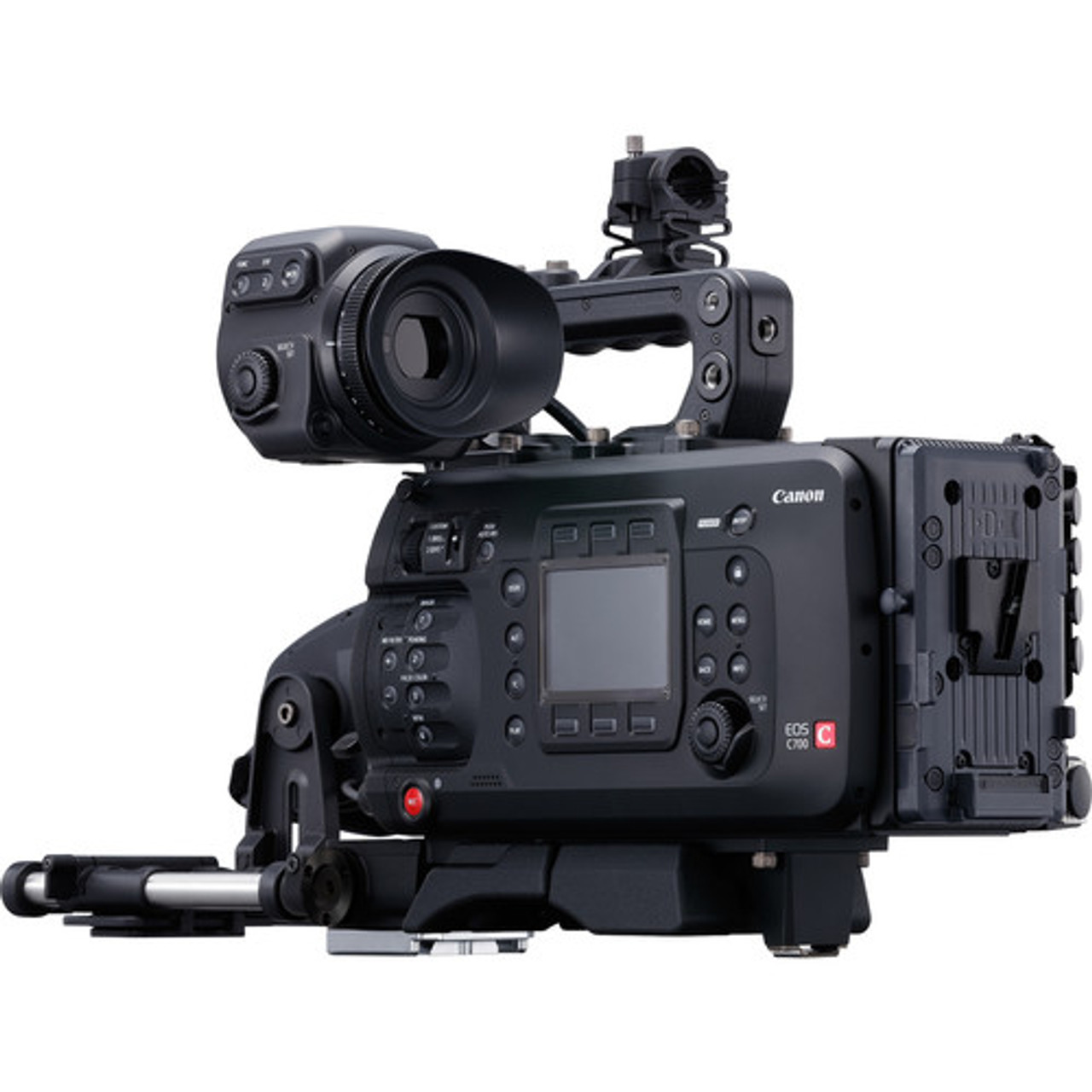Put Canon's mastery of image processing into a cinema-grade production-ready form factor and you get the EOS C700 Cinema Camera. This version of the C700 comes stocked with Canon's EF lens mount with a positive-locking mechanism, minimizing play found in traditional spring-loaded bayonet-style mounts. Beyond the lens mount is the first stop in the C700's imaging pipeline, the 4.5K CMOS image sensor.
With a physical resolution exceeding that of DCI 4K and a dynamic range of approximately 15 stops, the C700 is ready for today's 4K and HDR productions. What good is a sensor without the processing technology to back it up? The C700 is capable of 4K recording at 60p to CFast 2.0 cards using the XF-AVC format.
- Super 35mm CMOS Sensor
- EF Cinema Lock Type Mount
- Up to 15 Stops of Dynamic Range
- Dual Pixel CMOS AF
- 4K up to 60 fps, 2K/HD up to 240 fps
- Proxy Recording to SD Cards
- Selectable Gamma and Log Curves
- XF-AVC and ProRes Recording to CFast 2.0
- Intuitive User Interface
- Raw Recording Option
Canon EOS C700 Cinema Camera
Put Canon's mastery of image processing into a cinema-grade production-ready form factor and you get the EOS C700 Cinema Camera. This version of the C700 comes stocked with Canon's EF lens mount with a positive-locking mechanism, minimizing play found in traditional spring-loaded bayonet-style mounts. Beyond the lens mount is the first stop in the C700's imaging pipeline, the 4.5K CMOS image sensor. With a physical resolution exceeding that of DCI 4K and a dynamic range of approximately 15 stops, the C700 is ready for today's 4K and HDR productions.
What good is a sensor without the processing technology to back it up? The C700 is capable of 4K recording at 60p to CFast 2.0 cards using the XF-AVC format. Also available are Apple's well-regarded ProRes formats for direct-to-edit workflows. Raw recording is another possibility through Canon's separately available Codex Digital Recorder which simply clips onto the rear of the C700's modular design.
While the C700 is a fairly advanced piece of equipment, Canon has implemented a familiar user interface. Most basic functions can be accessed through the six buttons surrounding the screen. More advanced settings can be found using the simple selection dial and set buttons.
I/O options for nearly any application can be found on the C700's side panel. Video, audio, control, and power inputs and outputs are available for implementations ranging from ENG-style run-and-gun to high-budget cinema productions.
While the C700 is a production powerhouse all on its own, its modular design lets the user customize the form factor to fit their use case. The rectangular body has enough real-estate to be shoulder-mounted for handheld shooting or secured to a dovetail on professional grip equipment with ease. And for the first time on a Cinema EOS camera, native V-mount battery support is available via an installed IDX battery plate.
Recording Features
High Frame-Rate Support
Slow down the action with high frame rates. Crop in on the sensor for 2K frame rates up to 240 fps. With the separately available Codex Digital raw recorder, frame rates of up to 120 fps can be captured using the entire sensor.Internal ProRes Recording
The inclusion of Apple's ProRes codec inside the C700 enables shooters who require a quick turn-around to go direct-to-edit on many NLEs without any transcoding necessary. In 4K the 422 HQ flavor is implemented, and is supported up to 30 fps. In 2K mode, 10-bit 422, 10-bit 422HQ, and 12-bit 4444 can be used. High frame-rate recording is supported up to 180 fps using the 10-bit 422 flavor combined with the 2K center crop. All formats are conveniently recorded directly to the CFast 2.0 cards.Multi-Format Recording
Using the SD card slot, low-data-rate proxy files can be recorded simultaneously with XF-AVC or ProRes on the CFast 2.0 cards. Proxy files are useful for easy editing, either on-the-go, or with a less powerful computer to be linked up with the master files later on. Alternatively, the proxy files can be given to a client for review.Raw Recording
By removing the battery mount on the rear of the camera, and using the included bracket, a Codex Digital raw recorder can be installed using the included bracket. 12-bit DCI 4K raw files will be recorded onto separately available Codex Digital Capture Drives and will be instantly compatible with the robust Codex Digital workflow.Monitoring Features
HDR
If using monitors compatible with the SMPTE ST 2084 standard, you can connect to the monitor via SDI or HDMI outputs for vibrant images with enhanced dynamic range visibility over standard monitoring solutions. The separately available EVF-V70 OLED viewfinder has HDR simulation via a LUT that resembles the SMPTE ST 2084 standard for HDR preview monitoring in-camera.Surrounding Area
The viewfinder and monitoring outputs will display a translucent area around the image that is being recorded. Having that area lets the operator see what's happening outside the recorded frame.ACES Support
The C700 supports ACESproxy version 1.0. Connect it to an input device that supports ACESproxy to deliver a standardized color space in images at the shooting and editing locations, which improves workflow efficiency.Anamorphic De-Squeeze
Anamorphic lenses enable one-of-a-kind visual expression and are supported on the C700. When outputted to EVF or monitor outputs, the image is stretched to 2.39:1 after de-squeezing. Magnification factor can be set to OFF/2x/1.33x to match the anamorphic optics in use.General Features
Canon Log
Following in the tradition of the EOS C series cameras, the C700 offers Canon Log, Canon Log 2, and Canon Log 3 curves for recording.Canon Log 2 emphasizes post-production grading, and maintains higher tonality in dark areas compared to the original Canon Log. With this curve, up to 15 stops of dynamic range can be realized in a single frame.
Canon Log 3 uses a gamma designed to simplify grading by tightening dark areas and adjusting gradation, making it a gamma that makes noise less noticeable and widens dynamic range while retaining Canon Log's ease of use.
Dual Pixel CMOS AF
With phase-detection pixels covering 80% of the sensor area, quickly achieving accurate focus with compatible EF lenses is as simple as selecting an area and have the camera automatically focus on it. Face detection will lock the focus on a face inside the frame and track it as it moves through the frame. Different faces inside the frame are selectable. To ensure that focus is smooth, sensitivity can be adjusted in the menu.Another function of Dual Pixel AF is Dual Pixel Focus Guide, especially for manual focus confirmation. Select an area inside the frame and the UI will show if the lens is front or back focused from that point. Once critical focus is achieved the area will confirm immediately.
Lens Control
A 12-pin lens connection enables remote control of a compatible lens's focus, zoom, and iris functions, similar to that of a broadcast lens.B4 Lens Support
With the separately available B4 lens mount adapter, traditional 2/3" ENG lenses can be used in run-and-gun situations as they cover a large zoom range while remaining relatively compact.Intuitive Operation
In addition to several assignable buttons, six soft keys surround the control screen on the operator-side of the camera. Each of the six buttons can be set to adjust a different camera setting easily and intuitively. This menu system can be driven independently of the EVF menu. Deeper settings can be accessed using the dial, set key, as well as familiar home and back buttons.ND Filters
Dual motorized filter wheels hold 2, 4, and 6-stop ND filters. Using both wheels together in the extension mode enables even stronger 8 and 10-stop settings.Upgradability
The camera can grow with your productions as you require. If your workflow moves from EF-mount lenses a Canon service center can switch your mount. Additionally, the sensor block is factory-upgradable if you wish to switch to the global shutter sensor block.IP Streaming Support
IP streaming support lets users stream video online in real-time as they shoot. The C700 can connect with compatible IP decoders, IP streaming software and other devices, either through the on-board Ethernet connection or with a separately available Wi-Fi adapter, to enable live streaming to video websites or news programs within an existing video production and editing workflow, such as at a broadcast station.| Image Sensor Size | Super35 |
| Sensor Type | CMOS |
| Sensor Resolution | Actual: 4622 x 2496 (11.54 MP) Effective: 4096 x 2160 (8.85 MP) |
| Shutter Type | Rolling Shutter |
| ISO | 160 to 25,600 (Native) 100 to 102,400 (Expanded) |
| Gain | -2 to 42 dB (Native) -6 to 54 dB (Expanded) |
| Lens Mount | EF Cinema |
| Lens Communication | Yes, with Autofocus Support |
| Built-In ND Filter | Mechanical Filter Wheel with 2 Stop (1/4), 4 Stop (1/16), 6 Stop (1/64) ND Filters |
| Recording Media | 2 x CFast 2.0 Card Slots 1 x SDXC Card Slot |
| Raw Recording | Raw 12-Bit: 4096 x 2160 Raw 10-Bit: 4096 x 2160 |
| Recording Modes | ProRes 4:4:4 12-Bit: 2048 x 1080 1920 x 1080 XF-AVC 4:4:4 12-Bit: 2048 x 1080 1920 x 1080 XF-AVC 4:2:2 10-Bit: 4096 x 2160 3840 x 2160 ProRes 4:2:2 10-Bit: 4096 x 2160 3840 x 2160 |
| Gamma Curve | Canon Log, Canon Log 2, Canon Log 3, DCI-P3, Rec2020, Rec709, ST2084, Wide DR |
| IP Streaming | RTP, RTSP, UDP: 720 x 480 to 1920 x 1080 at 25p, 29.97p, 50i, 59.94i (1.5 to 9.0 Mb/s) |
| Video Connectors | 2 x BNC (3G-SDI) Monitor Output 4 x BNC (3G-SDI) Output 1 x HDMI Output |
| Audio Connectors | 2 x 3-Pin XLR Mic Level Input 1 x 1/8" / 3.5 mm Stereo Headphone Output |
| Other I/O | 1 x 12-Pin Lens Control 1 x BNC Timecode Input/Output 1 x BNC Genlock Output 1 x RJ45 |
| Wireless Interfaces | 2.4 GHz, 5 GHz Wi-Fi Control |
| Display Type | LCD |
| Screen Size | 3" |
| Screen Resolution | 1,036,000 Dots |
| Battery Type | V-Mount |
| Power Connectors | 1 x 4-Pin XLR (12 VDC) Input 1 x D-Tap (12 to 24 VDC at2 A) Output |
| Accessory Mount | 1 x 1/4"-20 Female 1 x 3/8"-16 Female |
| Dimensions | 6.6 x 6.1 x 12.9" / 16.7 x 15.4 x 32.7 cm |
| Weight | 7.6 lb / 3.4 kg |
| Package Weight | 6.67Kg |
| Box Dimensions (LxWxH) | 46.74cm x 34.80cm x 34.29cm |
In The Box
- 1 x Canon EOS C700 Cinema Camera
- 1 x Handle Unit
- 1 x Body Cap
- 1 x Tripod Adapter Base
- 4 x Base Feet
- 1 x WFT Attachment
- 1 x Mic Holder
- 2 x Measuring Hooks
- 1 x Reinforcing Plate for Codex Recorder
- 1 x Cable Clamp Base
- 1 x Allen Wrench
- 1 x Button Battery
- 1 x Limited 1-Year Warranty
Canon EOS C700 Cinema Camera
Put Canon's mastery of image processing into a cinema-grade production-ready form factor and you get the EOS C700 Cinema Camera. This version of the C700 comes stocked with Canon's EF lens mount with a positive-locking mechanism, minimizing play found in traditional spring-loaded bayonet-style mounts. Beyond the lens mount is the first stop in the C700's imaging pipeline, the 4.5K CMOS image sensor. With a physical resolution exceeding that of DCI 4K and a dynamic range of approximately 15 stops, the C700 is ready for today's 4K and HDR productions.
What good is a sensor without the processing technology to back it up? The C700 is capable of 4K recording at 60p to CFast 2.0 cards using the XF-AVC format. Also available are Apple's well-regarded ProRes formats for direct-to-edit workflows. Raw recording is another possibility through Canon's separately available Codex Digital Recorder which simply clips onto the rear of the C700's modular design.
While the C700 is a fairly advanced piece of equipment, Canon has implemented a familiar user interface. Most basic functions can be accessed through the six buttons surrounding the screen. More advanced settings can be found using the simple selection dial and set buttons.
I/O options for nearly any application can be found on the C700's side panel. Video, audio, control, and power inputs and outputs are available for implementations ranging from ENG-style run-and-gun to high-budget cinema productions.
While the C700 is a production powerhouse all on its own, its modular design lets the user customize the form factor to fit their use case. The rectangular body has enough real-estate to be shoulder-mounted for handheld shooting or secured to a dovetail on professional grip equipment with ease. And for the first time on a Cinema EOS camera, native V-mount battery support is available via an installed IDX battery plate.
Recording Features
High Frame-Rate Support
Slow down the action with high frame rates. Crop in on the sensor for 2K frame rates up to 240 fps. With the separately available Codex Digital raw recorder, frame rates of up to 120 fps can be captured using the entire sensor.Internal ProRes Recording
The inclusion of Apple's ProRes codec inside the C700 enables shooters who require a quick turn-around to go direct-to-edit on many NLEs without any transcoding necessary. In 4K the 422 HQ flavor is implemented, and is supported up to 30 fps. In 2K mode, 10-bit 422, 10-bit 422HQ, and 12-bit 4444 can be used. High frame-rate recording is supported up to 180 fps using the 10-bit 422 flavor combined with the 2K center crop. All formats are conveniently recorded directly to the CFast 2.0 cards.Multi-Format Recording
Using the SD card slot, low-data-rate proxy files can be recorded simultaneously with XF-AVC or ProRes on the CFast 2.0 cards. Proxy files are useful for easy editing, either on-the-go, or with a less powerful computer to be linked up with the master files later on. Alternatively, the proxy files can be given to a client for review.Raw Recording
By removing the battery mount on the rear of the camera, and using the included bracket, a Codex Digital raw recorder can be installed using the included bracket. 12-bit DCI 4K raw files will be recorded onto separately available Codex Digital Capture Drives and will be instantly compatible with the robust Codex Digital workflow.Monitoring Features
HDR
If using monitors compatible with the SMPTE ST 2084 standard, you can connect to the monitor via SDI or HDMI outputs for vibrant images with enhanced dynamic range visibility over standard monitoring solutions. The separately available EVF-V70 OLED viewfinder has HDR simulation via a LUT that resembles the SMPTE ST 2084 standard for HDR preview monitoring in-camera.Surrounding Area
The viewfinder and monitoring outputs will display a translucent area around the image that is being recorded. Having that area lets the operator see what's happening outside the recorded frame.ACES Support
The C700 supports ACESproxy version 1.0. Connect it to an input device that supports ACESproxy to deliver a standardized color space in images at the shooting and editing locations, which improves workflow efficiency.Anamorphic De-Squeeze
Anamorphic lenses enable one-of-a-kind visual expression and are supported on the C700. When outputted to EVF or monitor outputs, the image is stretched to 2.39:1 after de-squeezing. Magnification factor can be set to OFF/2x/1.33x to match the anamorphic optics in use.General Features
Canon Log
Following in the tradition of the EOS C series cameras, the C700 offers Canon Log, Canon Log 2, and Canon Log 3 curves for recording.Canon Log 2 emphasizes post-production grading, and maintains higher tonality in dark areas compared to the original Canon Log. With this curve, up to 15 stops of dynamic range can be realized in a single frame.
Canon Log 3 uses a gamma designed to simplify grading by tightening dark areas and adjusting gradation, making it a gamma that makes noise less noticeable and widens dynamic range while retaining Canon Log's ease of use.
Dual Pixel CMOS AF
With phase-detection pixels covering 80% of the sensor area, quickly achieving accurate focus with compatible EF lenses is as simple as selecting an area and have the camera automatically focus on it. Face detection will lock the focus on a face inside the frame and track it as it moves through the frame. Different faces inside the frame are selectable. To ensure that focus is smooth, sensitivity can be adjusted in the menu.Another function of Dual Pixel AF is Dual Pixel Focus Guide, especially for manual focus confirmation. Select an area inside the frame and the UI will show if the lens is front or back focused from that point. Once critical focus is achieved the area will confirm immediately.
Lens Control
A 12-pin lens connection enables remote control of a compatible lens's focus, zoom, and iris functions, similar to that of a broadcast lens.B4 Lens Support
With the separately available B4 lens mount adapter, traditional 2/3" ENG lenses can be used in run-and-gun situations as they cover a large zoom range while remaining relatively compact.Intuitive Operation
In addition to several assignable buttons, six soft keys surround the control screen on the operator-side of the camera. Each of the six buttons can be set to adjust a different camera setting easily and intuitively. This menu system can be driven independently of the EVF menu. Deeper settings can be accessed using the dial, set key, as well as familiar home and back buttons.ND Filters
Dual motorized filter wheels hold 2, 4, and 6-stop ND filters. Using both wheels together in the extension mode enables even stronger 8 and 10-stop settings.Upgradability
The camera can grow with your productions as you require. If your workflow moves from EF-mount lenses a Canon service center can switch your mount. Additionally, the sensor block is factory-upgradable if you wish to switch to the global shutter sensor block.IP Streaming Support
IP streaming support lets users stream video online in real-time as they shoot. The C700 can connect with compatible IP decoders, IP streaming software and other devices, either through the on-board Ethernet connection or with a separately available Wi-Fi adapter, to enable live streaming to video websites or news programs within an existing video production and editing workflow, such as at a broadcast station.| Image Sensor Size | Super35 |
| Sensor Type | CMOS |
| Sensor Resolution | Actual: 4622 x 2496 (11.54 MP) Effective: 4096 x 2160 (8.85 MP) |
| Shutter Type | Rolling Shutter |
| ISO | 160 to 25,600 (Native) 100 to 102,400 (Expanded) |
| Gain | -2 to 42 dB (Native) -6 to 54 dB (Expanded) |
| Lens Mount | EF Cinema |
| Lens Communication | Yes, with Autofocus Support |
| Built-In ND Filter | Mechanical Filter Wheel with 2 Stop (1/4), 4 Stop (1/16), 6 Stop (1/64) ND Filters |
| Recording Media | 2 x CFast 2.0 Card Slots 1 x SDXC Card Slot |
| Raw Recording | Raw 12-Bit: 4096 x 2160 Raw 10-Bit: 4096 x 2160 |
| Recording Modes | ProRes 4:4:4 12-Bit: 2048 x 1080 1920 x 1080 XF-AVC 4:4:4 12-Bit: 2048 x 1080 1920 x 1080 XF-AVC 4:2:2 10-Bit: 4096 x 2160 3840 x 2160 ProRes 4:2:2 10-Bit: 4096 x 2160 3840 x 2160 |
| Gamma Curve | Canon Log, Canon Log 2, Canon Log 3, DCI-P3, Rec2020, Rec709, ST2084, Wide DR |
| IP Streaming | RTP, RTSP, UDP: 720 x 480 to 1920 x 1080 at 25p, 29.97p, 50i, 59.94i (1.5 to 9.0 Mb/s) |
| Video Connectors | 2 x BNC (3G-SDI) Monitor Output 4 x BNC (3G-SDI) Output 1 x HDMI Output |
| Audio Connectors | 2 x 3-Pin XLR Mic Level Input 1 x 1/8" / 3.5 mm Stereo Headphone Output |
| Other I/O | 1 x 12-Pin Lens Control 1 x BNC Timecode Input/Output 1 x BNC Genlock Output 1 x RJ45 |
| Wireless Interfaces | 2.4 GHz, 5 GHz Wi-Fi Control |
| Display Type | LCD |
| Screen Size | 3" |
| Screen Resolution | 1,036,000 Dots |
| Battery Type | V-Mount |
| Power Connectors | 1 x 4-Pin XLR (12 VDC) Input 1 x D-Tap (12 to 24 VDC at2 A) Output |
| Accessory Mount | 1 x 1/4"-20 Female 1 x 3/8"-16 Female |
| Dimensions | 6.6 x 6.1 x 12.9" / 16.7 x 15.4 x 32.7 cm |
| Weight | 7.6 lb / 3.4 kg |
| Package Weight | 6.67Kg |
| Box Dimensions (LxWxH) | 46.74cm x 34.80cm x 34.29cm |
In The Box
- 1 x Canon EOS C700 Cinema Camera
- 1 x Handle Unit
- 1 x Body Cap
- 1 x Tripod Adapter Base
- 4 x Base Feet
- 1 x WFT Attachment
- 1 x Mic Holder
- 2 x Measuring Hooks
- 1 x Reinforcing Plate for Codex Recorder
- 1 x Cable Clamp Base
- 1 x Allen Wrench
- 1 x Button Battery
- 1 x Limited 1-Year Warranty


